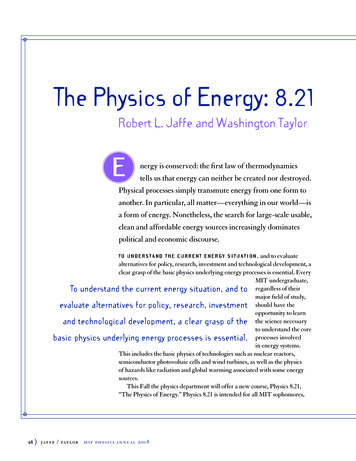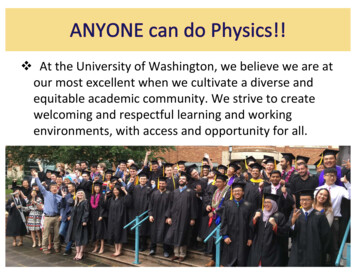
Transcription
The Physics of Energy: 8.21Robert L. Jaffe and Washington TaylorEnergy is conserved: the first law of thermodynamicstells us that energy can neither be created nor destroyed.Physical processes simply transmute energy from one form toanother. In particular, all matter—everything in our world—isa form of energy. Nonetheless, the search for large-scale usable,clean and affordable energy sources increasingly dominatespolitical and economic discourse.and to evaluatealternatives for policy, research, investment and technological development, aclear grasp of the basic physics underlying energy processes is essential. EveryMIT undergraduate,To understand the current energy situation, and to regardless of theirmajor field of study,evaluate alternatives for policy, research, investment should have theopportunity to learnand technological development, a clear grasp of the the science necessaryto understand the corebasic physics underlying energy processes is essential. processes involvedin energy systems.This includes the basic physics of technologies such as nuclear reactors,semiconductor photovoltaic cells and wind turbines, as well as the physicsof hazards like radiation and global warming associated with some energysources.This Fall the physics department will offer a new course, Physics 8.21,“The Physics of Energy.” Physics 8.21 is intended for all MIT sophomores,TO UNDERSTAND THE CURRENT ENERGY SITUATION,46 ) jaffe / taylormit physics annual 2008
juniors and seniors who want to understand the physical laws and processesthat govern the sources, extraction, transmission, storage, degradation andend uses of energy. Physics 8.21 is not aimed specifically at physics majors,but is designed to be accessible to any MIT undergraduate student whohas completed the physics, math and chemistry components of the GeneralInstitute Requirements, as well as any graduate student with a calculus-basedknowledge of mechanics and electromagnetism.Integrating Theory with ApplicationThe physics of energy involves a close interplay between underlying physicaltheory and applications. Thus, in 8.21 physical principles are developed intandem with their applications to energy science. The subject material isloosely divided into three parts,covered sequentially throughoutthe semester. The first part of thecourse focuses on end uses of energy.Analysis of basic energy needs suchas transport, heating and lightingprovide a context for reviewingbasic principles of mechanics andelectromagnetism. An introductionis then given to aspects of quantummechanics and thermodynamicsthat are central to understandingquestions in energy physics, such asthe limits to efficiency of conversionfrom heat energy to mechanicalenergy in an automobile engine.The second part of the courseMost energy used by humans has its origin in the sun. Nuclear fusion reactions in the sun produce energy which isfocuses on sources of energy. Thistransmitted by electromagnetic radiation to earth. This enormous flux of energy powers almost all earth systems:biological systems, including the origins of fossil fuels; wind, wave and ocean energy systems; as well as humanmaterial represents a significantproduced photovoltaics for direct conversion of solar energy into electricity. (Image courtesy of Prof. Thomas Greytak.)fraction of the course. Furtherdevelopment of quantum mechanicsprovides the background for understanding fission and fusion reactors andradiation, waste and proliferation hazards. The progress of solar energyis followed from its release in nuclear fusion reactions in the sun, throughradiation to the earth and absorption and use in terrestrial systems, integratingmaterial from several branches of physics. This leads to analysis of solarthermal energy plants and development of the basic physics of semiconductorsmit physics annual 2008 jaffe / taylor( 47
necessary to understand photovoltaic technology (PV), including currentsilicon-based PV and alternative approaches that may be used in the future.Next, basic fluid dynamics is developed and used to describe the physics ofwind and other renewable resources including hydro, tidal, wave and oceanpower. Geothermal energy is also discussed. Less time is spent on biofuels andfossil fuels, as the issues here are based more in biology and chemistry, althoughsome important physics aspects of these energy sources are discussed. Basicatmospheric physics and the physics of climate change are covered in severallectures. In the third part of the course, a deeper study of thermodynamicsis integrated with a study of energy conversion, storage and transmissionmethods. The course concludes with a discussion of conservation and anoverview of the contemporary energy landscape.Thematic UnityAs well as providing students with a strong foundation in the science of energy,Physics 8.21 integrates many different subfields of physics, giving students anopportunity to acquire a global picture of how the core ideas of modern physicspermeate our understanding of nature and technology. The introductoryphysics courses 8.01 and 8.02 acquaint students with the fundamentalprinciples of mechanicsand electromagnetism.Physics 8.21 will provide the scientific foundation for These domains of classicalphysics, which were wellintelligent analysis of the tough political, economic, understood in the 19thcentury, form a foundationsocial and ethical issues which need to be resolved to for much of modernphysical science andfind sustainable, long-term energy solutions. associated technology. MostMIT undergraduates whodo not major in physics or closely related sciences do not, however, encountermany of the new ideas which have entered physics in the last century. Thedevelopment of quantum mechanics and the consequent deeper insight intothermodynamics from statistical physics, in particular, has led to a much richerunderstanding of many physical systems and to many new technologies thatwill figure in the energy systems of the 21st century. Physics 8.21 introducesand applies those aspects of quantum mechanics and thermodynamics whichare relevant for energy systems. The thread of energy ties together physicalconcepts that would otherwise be encountered in separate courses, and couldthus seem disparate and disconnected to students.48 ) jaffe / taylormit physics annual 2008
Despite the wide range of material covered, 8.21 is not a survey course. Thecourse is focused upon the fundamental physical principles underlying energyprocesses, and on the application of these principles to practical calculations.Quantitative analysis will be emphasized, and many analytical tools willbe introduced and applied which will be new to the students. Physics 8.21will provide the scientific foundation for intelligent analysis of the toughpolitical, economic, social and ethical issues which need to be resolved to findsustainable, long-term energy solutions. Much of the reading and backgroundmaterial for 8.21 is being created specifically for this course, as existingintroductory books and resources on energy physics are written for audienceswithout the mathematics and physics background of MIT undergraduates.OutlookAfter its debut in the Fall 2008 semester, Physics 8.21 will be offered again inthe Fall of 2009 and 2010. The content of the course will undergo a progressiverefinement each time the course is taught, aiming for the right balance oftheoretical development and practical application to both educate students onthe physical principles and enable them to apply their understanding to a widerange of energy systems. This will present an important challenge, both tothe educators and to the students. We hope that this course will provide someassistance to the next generation of talented MIT students, who will inherit thegreater challenge of developing sustainable energy systems for the future, andwho we hope will play leadership roles in facing it successfully.robert l. jaffe is the Jane and Otto Morningstar Professor of Physics at MIT, and theformer Director of the MIT Center for Theoretical Physics. Jaffe received his AB in Physicsfrom Princeton, and his MS and PhD degrees from Stanford in 1971 and 1972, respectively.In 1972, Jaffe came to MIT as a postdoctoral research associate in the Center for TheoreticalPhysics. He joined the faculty in 1974. Jaffe has served on the program advisory committees ofseveral national laboratories and for many years he was the chairman of the Advisory Councilof the Physics Department of Princeton University. He now serves as Chair of the Science andTechnology Steering Committee of Brookhaven National Laboratory. Jaffe is a Fellow of theAmerican Physical Society and the American Association for the Advancement of Science.Jaffe has been awarded departmental, school and Institute prizes for excellence in teaching,culminating in 1998, when he was named a Margaret MacVicar Faculty Fellow (1998) inrecognition of his many contributions to education at MIT.Professor Jaffe’s research specialty is the physics of elementary particles and quantum fieldtheory, especially the dynamics of quark confinement and the Standard Model. Most recently heJaffe / Taylor continuedmit physics annual 2008 jaffe / taylor( 49
Jaffe / Taylor continuedhas been researching the dynamical effects of the quantum vacuum (Casimir Effects) on micronscales. He has also worked on the quantum theory of tubes, the astrophysics of dense matter andmany problems in scattering theory. Jaffe teaches quantum mechanics, field theory, mechanicsand electrodynamics at the advanced undergraduate and graduate levels.washington taylor is a Professor of Physics in the MIT Center for Theoretical Physics(CTP). Taylor received his BA in mathematics from Stanford, and his PhD in physics fromUC-Berkeley in 1993. He came to MIT as a postdoc in the CTP in 1993. Taylor joined thefaculty at Princeton University in 1995, and returned to MIT in 1998, where he was appointedthe Class of 1942 Career Development Professor in 2000, and became a full professor in2002. Taylor has been an Alfred P. Sloan Research Fellow and a DOE Outstanding JuniorInvestigator.Professor Taylor’s research interests are centered on basic theoretical questions related toquantum physics and gravity. His recent work has focused on exploring the large number ofapparent solutions to string theory and connections between these solutions and observableparticle physics and cosmology. Taylor teaches undergraduate and graduate courses ranging fromelectromagnetism through quantum field theory.50 ) jaffe / taylormit physics annual 2008
Physics 8.21 integrates many different subfields of physics, giving students an . opportunity to acquire a global picture of how the core ideas of modern physics permeate our understanding of nature and technology. The introductory physics courses 8.01 and 8.02 acquaint students with the fundamental principles of mechanics and electromagnetism.











